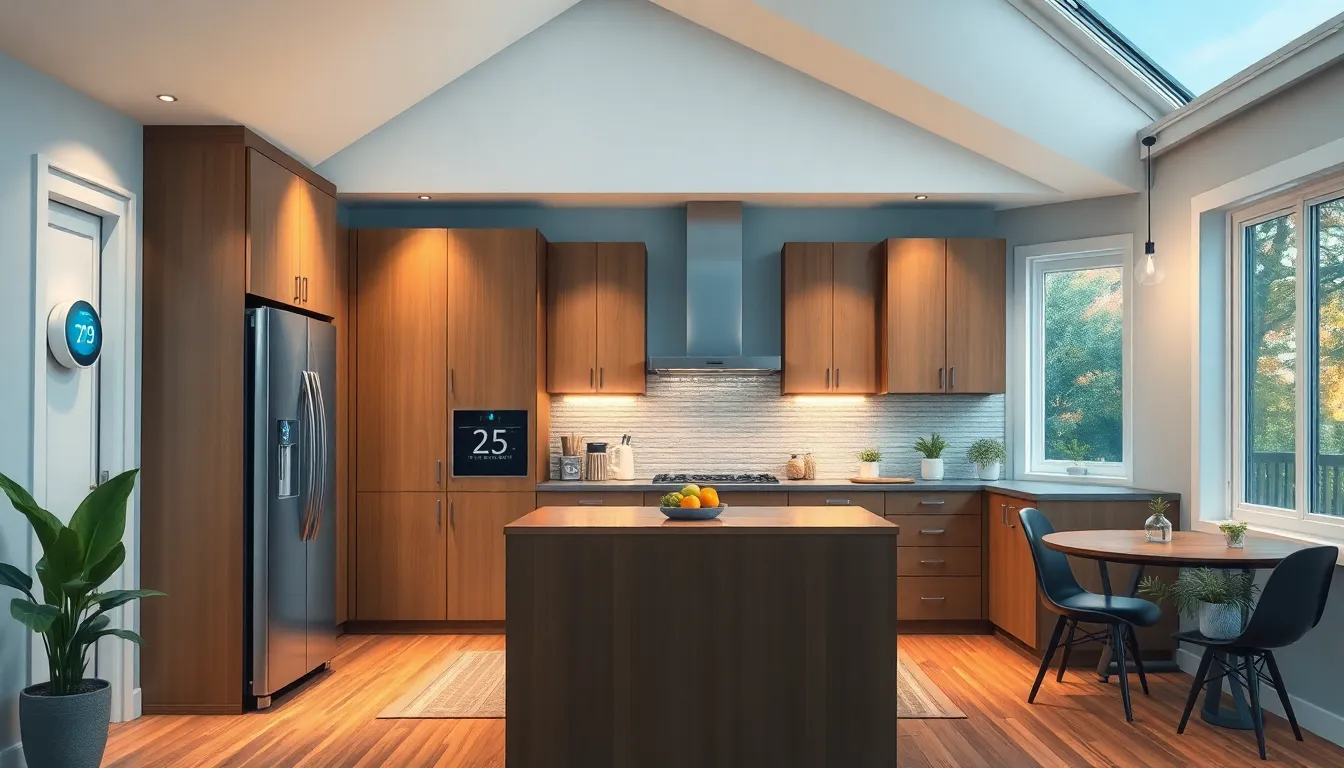In a world where energy bills can feel like a black hole for your wallet, energy-efficient upgrades are the superheroes we never knew we needed. Imagine slashing those pesky utility costs while also saving the planet—it’s a win-win situation. From swapping out old light bulbs for snazzy LEDs to upgrading appliances that practically run on fairy dust, these upgrades can transform any home into an eco-friendly haven.
But don’t worry, going green doesn’t mean living like a caveman. With a bit of savvy, homeowners can embrace modern technology and stylish designs that keep energy consumption low while comfort levels soar. So, let’s dive into the world of energy-efficient upgrades that are not just smart choices, but also surprisingly fun! After all, who knew saving the planet could come with a side of style?
Table of Contents
ToggleUnderstanding Energy-efficient Upgrades
Energy-efficient upgrades offer practical solutions for homeowners looking to reduce utility expenses while promoting sustainability. Common choices include LED lighting, which uses at least 75% less energy than traditional incandescent bulbs, and they last up to 25 times longer. Energy-efficient appliances represent another smart option, often certified by ENERGY STAR, delivering significant energy savings without compromising performance.
Smart thermostats allow for better control of heating and cooling systems, adjusting temperatures automatically based on user behavior. Homeowners can save an average of 10% to 12% on heating and cooling costs yearly by implementing such technology. Insulation plays a critical role in energy efficiency as well; properly insulated homes can reduce energy loss by up to 30%.
Replacing older windows with double-pane or triple-pane options minimizes heat transfer, further enhancing comfort and efficiency. Solar panels provide an opportunity for homeowners to harness renewable energy. Those who install solar systems often experience reduced electricity bills and may be eligible for tax credits and incentives.
In addition to financial benefits, many energy-efficient upgrades improve overall home comfort and air quality. Upgrades like low-flow fixtures reduce water usage, conserving a precious resource while lowering bills. Choosing energy-efficient options demonstrates an investment in a healthier planet, aligning with growing environmental consciousness among consumers. Exploring these upgrades contributes to a more sustainable future and allows homeowners to enjoy a stylish, efficient living environment.
Benefits of Energy-efficient Upgrades

Energy-efficient upgrades provide compelling benefits for homeowners. These enhancements result in substantial cost savings and positively impact the environment.
Cost Savings
Cost savings represent a key advantage of energy-efficient upgrades. Homeowners experiencing reduced utility bills often see savings of 10% to 30% with the implementation of energy-efficient appliances and lighting. LED lighting consumes at least 75% less energy than traditional bulbs, reflecting significant savings over time. The integration of smart thermostats allows for precise climate control, further lowering heating and cooling costs. These technologies, often qualifying for rebates or incentives, provide immediate financial benefits and long-term reductions in expenses.
Environmental Impact
Environmental impact influences the appeal of energy-efficient upgrades. Upgrades like double or triple-pane windows and high-quality insulation minimize energy loss, enhancing overall home efficiency. They contribute to reduced greenhouse gas emissions by lowering energy consumption. Utilizing solar panels harnesses renewable energy, decreasing dependency on fossil fuels. These choices align with a growing environmental consciousness, demonstrating a commitment to sustainability. Additionally, improved air quality indoors results from better insulation and energy-efficient systems, benefiting both occupants and the planet.
Types of Energy-efficient Upgrades
Energy-efficient upgrades take various forms, significantly enhancing a home’s efficiency and sustainability. Homeowners can choose from several options, including insulation improvements, energy-efficient appliances, and smart thermostats.
Insulation Improvements
Insulation improvements dramatically reduce unwanted heat transfer. Effective insulation minimizes energy loss, enhancing overall comfort while lowering heating and cooling costs. Upgrading to high-quality insulation materials can yield energy savings of up to 20%. Options include spray foam, fiberglass, and rigid foam boards. Each material provides unique benefits in energy retention. Properly insulating attics, walls, and floors contributes to a more stable indoor temperature. This stability translates into lower energy consumption and increased savings.
Energy-efficient Appliances
Energy-efficient appliances significantly impact utility bills. These appliances, often certified by ENERGY STAR, use 10% to 50% less energy compared to standard models. Replacing outdated refrigerators, washers, and dishwashers with energy-efficient alternatives enhances performance while promoting sustainability. Many appliances feature advanced technologies that optimize energy use without compromising functionality. Homeowners experience reduced electricity consumption and enjoy improved reliability. Choosing energy-efficient appliances helps create a greener household and contributes to long-term savings.
Smart Thermostats
Smart thermostats provide enhanced control over indoor climate. These devices adjust heating and cooling based on the homeowner’s schedule and preferences. Users can save 10% to 12% on energy costs by utilizing smart scheduling features. Some models learn individual behaviors, optimizing energy use even further. Remote access through smartphones allows for adjustments when homeowners are away. Investing in a smart thermostat leads to increased comfort and efficiency. Overall, these devices play a crucial role in reducing energy consumption in the home.
How to Implement Energy-efficient Upgrades
Implementing energy-efficient upgrades enhances home comfort and lowers utility costs. Starting with a clear plan simplifies the process and maximizes benefits.
Assessing Your Home
Evaluating a home’s current energy performance stands as the first step. Inspect insulation quality, as inadequate insulation often contributes to significant heat loss. Identify old appliances and lighting, which might consume excessive energy. Checking windows for drafts presents another opportunity for improvement. Home energy audits can uncover inefficiencies, guiding homeowners toward specific upgrades. Energy-efficient assessments might involve professional help to identify trouble spots accurately. Comprehensive evaluations highlight urgent upgrade needs, enhancing overall performance and comfort.
Finding Qualified Professionals
Selecting skilled professionals for energy-efficient upgrades streamlines the project. Begin by researching contractors specializing in energy-efficient solutions. Local referrals or online reviews guide homeowners towards reputable services. Verify credentials and certifications to ensure quality workmanship. ENERGY STAR partners often provide trusted lists of qualified professionals. Many professionals offer initial consultations, allowing homeowners to discuss needs and potential improvements. Getting multiple quotes helps assess cost and service offerings, ensuring the best fit for the project. Committing to trusted experts guarantees successful implementation and maximizes long-term benefits.
Embracing energy-efficient upgrades transforms a home into a more sustainable and cost-effective space. Homeowners can enjoy the dual benefits of reduced utility bills and a positive environmental impact. By investing in modern technologies like smart thermostats and energy-efficient appliances, they not only enhance comfort but also contribute to a greener planet.
With a variety of options available, from improved insulation to solar panels, making these upgrades is both practical and rewarding. As they explore these enhancements, homeowners will find that achieving efficiency doesn’t mean sacrificing style or comfort. Taking the first step toward a more energy-efficient home is an investment in both financial savings and a healthier environment for future generations.


